Francesco Sisto interview
THE DESCRIPTION OF A BOAT
Let’s use the hull of our “shark” to describe in a simple way the main parts of a boat, starting from the stern which, let’s remember, is the rear part of a boat.
We have this horizontal, flat element, which is called the “transom”.
From the stern to the bow we have this powerful structural element, which runs from the stern to the bow and is called the keel.
The keel could be called the backbone of the boat, supporting the entire structure and the entire hull.
Just as the ribs of the human body are mounted at right angles to the spine, so too are the so-called “ribs of the boat”.
And you can see them here, painted orange.
They serve to give the main structure and rigidity to the hull.
The entire section that goes from below the keel and that goes down to give stability and weight to the boat is called the bulb, and that is all this flat part,
this sort of fin that from the stern, which is this area that I’m showing you up to the stem, to the foremost point of the bow helps to give stability to the boat, and prevents the boat tipping over in the wind;
in jargon it’s called “scuff”.
So this whole area here is the centre of the boat’s mass: in fact, this area that I am touching is not made of wood, but in this case it is made of cast iron, solid cast iron, but in the past, it was also made of lead, so a durable metal.
Continuing from the stern to the bow, we obviously have the hull, which in the case of wooden boats is made of planking, because they are bands that are nailed onto the structural elements,
and therefore onto the ribs, the resistant elements.
We arrive in the so-called “midships” area, which in the specific case of the shark is here, i.e. the part where we have the “overall” width, i.e. the maximum width, the maximum bulk of the boat:
this is called the “main section”.
This whole section here is called “mascone” (the starboard and port bow). Something very important – everything above the waterline is called “dead work” (freeboard) and everything below the waterline
is called the “living work” (hull).
“Living work” because it contributes to the buoyancy of the boat and is referred to as “alive”.
Continuing to follow the profile of the keel, we see that after the bulb we have this element which, little by little, moves towards the foremost section of the bow: this area of the keel is called the “stem”,
i.e. the curved part which, from a horizontal position, soars upwards and then joins at foremost point of the bow,
which is the conjunction with the deck.
And then, lastly, the final part, the point we have been talking about so far, is called the prow.
What you see behind me is a “shark”.
A cutter of around 8.20 metres, which our workshop is in the process of completely restoring.
The more specific term is “refitting” because during refitting the workers and craftsmen try to rebuild all the parts that have deteriorated and to preserve the original parts that are in good condition,
and still exhibit a material response adequate for use.
A “shark” is a pleasure boat, it is a sailing boat, it is the ancestor of the modern sloop, of the modern classic sailing boats that we are used to seeing in our harbours, and it was a boat that was used exclusively for leisure.
One important thing about shark-type boats is that, despite their substantially reduced size, they have complex characteristics so they can be an excellent training ground for practising building ships that are even a little more complicated.
Why? Cutters are already beginning to have a level of complexity in terms of their structural composition that brings them closer to larger classes of vessels, almost up to the level of ships such as ancient ships.
Why? Because in addition to having a hull, a keel and ballast, they also have a deck, a cabin, superstructures and manoeuvring areas that require specific construction know-how for this type of craft.
Let’s say that “sharks”, vintage cutter boats of this type, are an excellent training point.
*** Automatically generated subtitles ***


